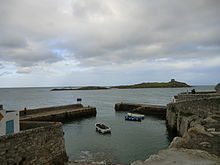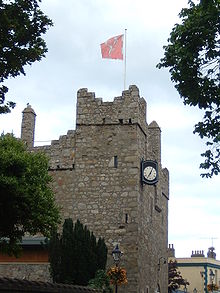- Dalkey
-
Dalkey
Deilginis— Suburb of Dublin — Castle Street with Dalkey Castle Location in Ireland Coordinates: 53°16′34″N 6°06′14″W / 53.276°N 6.104°WCoordinates: 53°16′34″N 6°06′14″W / 53.276°N 6.104°W Country Ireland Province Leinster County Dun Laoghaire-
RathdownElevation 26 m (85 ft) Population (2006)[1] - Urban 8,083 Irish Grid Reference O264267 Dalkey (Irish: Deilginis, meaning "thorn island") is suburb of Dublin and seaside resort in Dun Laoghaire-Rathdown County, Ireland. It was founded as a Viking settlement and became an important port during the Middle Ages. According to John Clyn, it was one of the ports through which the plague entered Ireland in the mid-14th century. In modern times, Dalkey has become a thriving seaside suburb and a minor tourist attraction.
Contents
Etymology
The town is named after Dalkey Island, just offshore. The name is a meld of the Irish deilg (meaning "thorn") and the Old Norse øy (meaning "island"). The Island is the Shape of a thorn, Hence, "Thorn Island" (Deilg Inis) Inis means Island in Irish.
Local amenities
Quarry
Dalkey Quarry is a disused granite quarry, stone from which was used during the 19th century to build Dún Laoghaire harbour, and is now a popular rock climbing location within Killiney Hill Park. During the building of the harbour, the quarry was connected to Dún Laoghaire via a metal tramway known as 'The Metals', which are still visible in some parts of Dalkey.
Harbours
There are several small harbours on the coast of Dalkey. Bulloch Harbour is the biggest; it is towards the northern part of Dalkey, and is a declared seal sanctuary. Coliemore Harbour is much smaller, and is in the southern part of Dalkey. It was formerly the main harbour of Dublin City. These harbours are used by tourists to hire boats for nearby fishing, and for getting to Dalkey Island.
Sports
Cuala CLG, a prominent Gaelic Athletic Association sports club, and Dalkey United, an association football club, are both based at Hyde Park. Early in his soccer career, Paul McGrath played for Dalkey United. In the 1940s, the town produced another footballer of note, Peter Farrell. Recently it has set up an athletics club, the Dalkey Dashers.
Education
There are five schools in Dalkey. Loreto Primary School caters for boys from junior infants through first class, and for girls from junior infants through sixth class. Loreto Abbey Secondary School caters for girls from first year through sixth year. Harold Boys' National School caters for boys from second class through sixth class, and Saint Patrick's National School caters for boys and girls from junior infants through sixth class. Castlepark School is an independent preparatory school for boys and girls.
Transport
The Dalkey Atmospheric station at Atmospheric Road (29 March 1844 to 12 April 1854)[2] was the terminus for the first commercial application of the atmospheric system of train propulsion.[3]
The current Dalkey railway station was opened on 10 July 1854. The station is served by the DART, which passes through a tunnel south of Dalkey, emerging on a cliff giving spectacular views over Killiney Bay.
An Aircoach service starting at Hyde Park on the Hyde Road links the area with Dublin Airport whilst Dublin Bus services 59, 7d and 8 link the area with the city centre.
People
Dalkey is the original home town of three well-known Irish writers, novelists Maeve Binchy and Roddy Doyle, and playwright Hugh Leonard. It is also the setting for Flann O'Brien's novel The Dalkey Archive. In recent years several well-known Irish and international figures bought property in the area such as U2 members Bono and The Edge; Enya, the music artist; and musicians Chris de Burgh and Van Morrison. Former host of the Late Late Show, Pat Kenny, and TV3 current affairs host Vincent Browne are residents. Film directors Neil Jordan and Jim Sheridan also live in the town, while Formula One drivers Damon Hill, Eddie Irvine, used to live in Dalkey. Gavin O'Reilly, CEO of the Independent News & Media of Ireland and his (separated) wife, actress and model Allison Doody, lived at Bartra House,[4] a 10,000-square-foot (930 m2) home overlooking the sea.
Wildlife
Dalkey Island is home to a colony of seals which has greatly expanded in recent years. A herd of wild goats live on the island also. Birdwatch Ireland have established a colony of Roseate Terns on Maiden Rock just north of Dalkey Island. More recently a pod of three bottlenose dolphins has begun frequenting the waters around Dalkey Island.
See also
References
- ^ "Census 2006 – Volume 1 – Population Classified by Area" (PDF). Central Statistics Office Census 2006 Reports. Central Statistics Office Ireland. April 2007. http://www.cso.ie/census/documents/census2006_volume_1_pop_classified_by_area.pdf. Retrieved 2011-06-12. Note: The figure given is the sum of the populations of the Dalkey-Avondale, Dalkey-Bullock, Dalkey-Coliemore, Dalkey Hill and Dalkey Upper sections of the area.
- ^ "Dalkey station". Railscot - Irish Railways. http://www.railscot.co.uk/Ireland/Irish_railways.pdf. Retrieved 2007-08-31.
- ^ Industrial Heritage Ireland
- ^ Hughes, Emer (2 March 2003). "Rich chase streets of dreams". ThePost.ie. http://archives.tcm.ie/businesspost/2003/03/02/story521590034.asp. Retrieved 18 May 2008.
External links
- Dalkey Community Council
- Local website
- Dalkey walks
- Dalkey Castle and Heritage Centre
- Sorrento Cycling Club
- Harold Boys' National School
- Saint Patrick's National School
- Castle Park School
- Dalkey Quarry Rock Climbing Guide
Places in Dún Laoghaire–Rathdown Towns Villages Ballinteer · Ballybrack · Blackrock · Booterstown · Cabinteely · Carrickmines · Cherrywood · Churchtown · Dalkey · Deansgrange · Dundrum · Foxrock · Goatstown · Glasthule · Glenageary · Johnstown · Killiney · Kilmacud · Kilternan · Leopardstown · Loughlinstown · Monkstown · Rathfarnham · Sandyford · Sandycove · Sallynoggin · Stepaside · Stillorgan
Category:Mountains and hills of County Dublin · Category:Rivers of County Dublin · Category:Geography of County DublinCategories:
Wikimedia Foundation. 2010.







